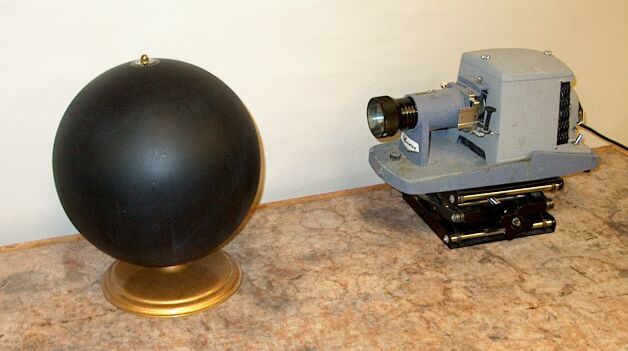
With the demonstration set up as shown above, you can have students sitting in different parts of the lecture hall note what portion of the globe’s surface is illuminated – what phase they observe. Alternatively, you could place the globe and projector so that you can vary the direction from which the globe is illuminated.
As the Moon orbits the Earth, the orientation of our line of sight to it with respect to the direction from which the Sun illuminates it (and the Earth) changes. This causes a variation in the portion of the sunlit face of the Moon that is visible to us, and the Moon exhibits phases. The continuous increasing and decreasing of the portion of the sunlit side of the Moon that is visible – the Moon’s waxing and waning – is divided into eight phases:
1) The cycle begins with the new Moon, which occurs when the Moon is exactly between the Earth and the sun; its lit side faces away from us, and the Moon is practically invisible in the sky.
2) Shortly after the new Moon, a small portion of the lit face becomes visible, and the Moon appears as a waxing crescent, which continues to grow.
3) After a week, the line from the Moon to the Earth is 90° to the line from the Sun to the Earth, and half the sunlit face of the Moon is visible. This phase is the first quarter.
4) As the visible portion of the sunlit face continues to increase we see a waxing gibbous.
5) After two weeks, the Moon is exactly opposite from the Sun (the Earth is now between it and the Sun), and the entire sunlit face is visible. This is a full moon.
6) From this point, the portion of the sunlit face that is visible begins to decrease, and we see a waning gibbous.
7) After 22 days, the line from the Moon to the Earth is again 90° to the line from the Sun to the Earth, and half the sunlit face is again visible (the opposite half to what was visible at the first quarter). This is the third quarter.
8) The Moon then appears as a waning crescent.
When about 29.5 days have elapsed, the Moon again appears as a new moon, and the cycle repeats.
With the demontration set up as shown above, students on the left side of the lecture hall should see a waning gibbous, the lit portion appearing largest for those near the front of the room, and smallest for those near the back. Those whose line of sight to the globe is perpendicular to the line from the projector to the globe should see a third quarter. Students on the right side of the lecture hall should see a waning crescent, the lit portion appearing largest for those near the back of the room, and smallest for those near the front.
According to its position with respect to the stars (the celestial sphere; see demonstration 92.06 -- Celestial globe), it takes the Moon about 27.3 days to complete its orbit. This period is called the sidereal month. Because the Earth-Moon system in turn orbits the Sun in the same direction in which the Moon orbits the Earth, during a sidereal month the line from the Earth to the Sun rotates through an angle of about 27.3 degrees. (This line rotates at about 360 degrees/365.2 days, or about 0.986 degrees per day.) The line from the Earth to the Moon is parallel to the direction it had 27.3 days earlier, but the Moon must travel a bit further before it is again between the Earth and the Sun. This takes a little more than two days, so the new Moon occurs after about 29.5 days have elapsed as noted above. This 29.5-day period is called the synodic month.
The department of astronomy education at University of Nebraska-Lincoln, as part of the Nebraska Astronomy Applet Program (NAAP), created a wonderful simulation that shows the phases of the Moon, and how they occur. You can run that simulation at https://astro.unl.edu/naap/lps/animations/lps.html.
Galileo observed that Venus exhibits phases. Because Venus’s orbit lies within that of the Earth, the orientation of its sunlit side varies in relation to our line of sight to it, and we observe a complete cycle of phases. Mercury, whose orbit also lies within Earth’s orbit should also exhibit phases. We do observe phases for Mecury, but its proximity to the Sun makes it impossible to see the complete cycle. For the outer planets, our line of sight can vary with respect to the orientation of the sunlit side, but the effect of this is generally slight.
References:
1) Chaisson, Eric and McMillan, Steve, Astronomy Today. (Upper Saddle River, New Jersey: Prentice-Hall, Inc., 1999) pp. 14-16, 40-41, 176-177.
2) Wolfram Demonstrations Project – Phases of Planets.